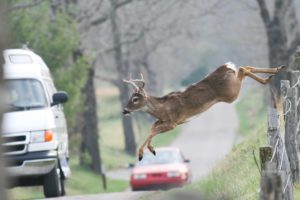Be On the Look Out for Deer While Driving

With the bow season underway, together with greater activity due to mating season, we need to be reminded that deer accidents are most common from October through December. Today there are an estimated 1.5 million deer in Pennsylvania. November is the month in which you are most likely to have a deer-related collision. If you drive in Pennsylvania, you have a 1 in 70 chance of being involved in a deer-related accident. Only in West Virginia and Montana do you have a greater chance of striking a deer with your vehicle. The most common time to strike a deer is between 6 PM and 9 PM and unfortunately, deer kill approximately 120 people each year. Deer vs. vehicle collisions are the top animal-related insurance claim in the United States.
So what can you do to avoid hitting a deer? Here are six tips.
1) Remember that deer travel in groups. If one deer successfully crosses the road in front of you, be sure to be looking for others that are soon to follow. Most people miss hitting the first deer they see and hit the second one.
2) Travel with a heightened state of awareness during this season. While deer crossroads at all hours of the day, they are more active at dusk and at dawn. If you are traveling when it is dark, use your high beams as much as possible in order to see as much of the sides of the roadway as possible. Be aware of areas where you have seen deer before, as deer often travel the same pathways.
3) If you see a deer crossing sign, know that the sign was installed by PennDOT because of prior reported collisions with deer on that part of the roadway. Be more intentional in scanning the sides of the roadways, when driving on roads marked by deer crossing signs.
4) If you see deer on the sides of a roadway, let other travelers coming from the opposite direction know of the danger, by flashing your headlights. The hope is that the other drivers will recognize that there is a potential hazard up ahead; slow down, and be more vigilant moving forward.
5) Resist the urge to tailgate if the vehicle in front of you is driving especially slow. The first vehicle in a line of traffic does not have the benefit of being able to visualize as great a distance as the cars traveling behind it. If the vehicle in front of you must make a sudden stop for a deer crossing the road, you need to have an assured clear distance between both vehicles in order to bring your car to a stop without causing a collision.
6) Recognize that it may be safer to simply hit the deer than to swerve in an attempt to avoid it. Swerving can cause you to go into oncoming traffic or to travel off the road and into a more dangerous object than a deer.
If you strike a deer, pull your vehicle off to the side of the road and assess the damage in order to know whether your car is safe to continue to drive. While you are not required to call the police when you strike a deer, it can be a good idea to do so, if you intend on filing an insurance claim. Damage to your vehicle caused by striking a deer falls under the “comprehensive” portion of your insurance coverage and not under the collision coverage.
And what about those “deer whistles” some people put on the front bumpers of their cars? While research has shown that deer can hear the whistles, the conclusion of the experts seem to be that by the time the deer hear the whistle, it is too late, as the deer is already in the roadway. However, we know of some people who swear by these gadgets.
Since 1985, the personal injury attorneys at Drake, Hileman & Davis, have been concerned for the safety of those in our community. We have been helping the injured find answers, whenever accidents happen. We have a proven track record of results and satisfied clients. We’re ready to answer your questions and provide you with the legal help you need. Contact us on-line or call us at 1-888-777-7098 to schedule your free consultation in the convenience of your home or at one of our five offices located throughout the region.

